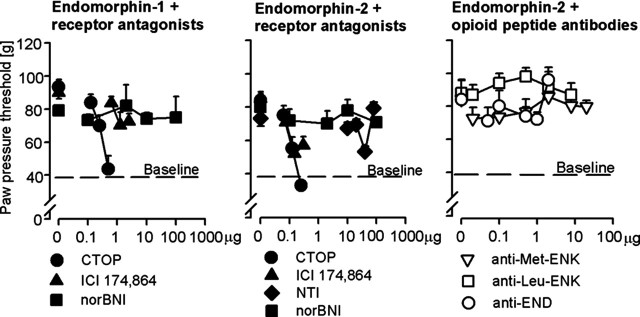Figure 2.
Opioid receptor selectivity of exogenous EM-1- and EM-2-induced antinociception. Left, EM-1-induced antinociception was dose dependently blocked by μ-receptor (CTOP) but not δ-receptor (ICI 174,864) or κ-receptor (norBNI) selective antagonists (p < 0.001, ANOVA, linear regression; p > 0.05, ANOVA, respectively). Middle, EM-2-induced antinociception was dose dependently blocked by μ-receptor (CTOP) and attenuated by δ-receptor (ICI 174,864 and naltrindole) selective antagonists (p < 0.001, ANOVA, linear regression). EM-2-induced antinociception was not significantly changed by a κ-receptor (norBNI) selective antagonist (p > 0.05, ANOVA). Right, EM-2-induced antinociception was not significantly changed by antibodies against Met-enkephalin (anti-Met-ENK), Leu-enkephalin (anti-Leu-ENK), and β-endorphin (anti-END) (p > 0.05, ANOVA). Receptor antagonists and peptide antibodies were coadministered intraplantarly into inflamed paws with either EM-1 or EM-2. PPTs were measured 5 min after injections. Dashed lines represent baseline paw-pressure thresholds of representative groups and are 40 ± 1.2 g. Data are expressed as means ± SEM.

